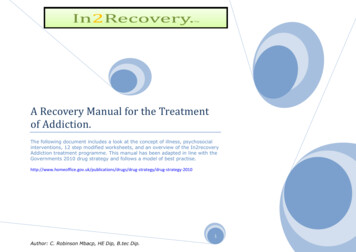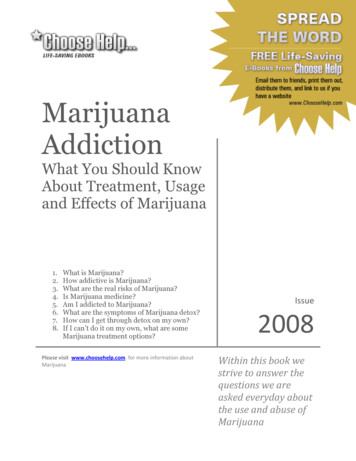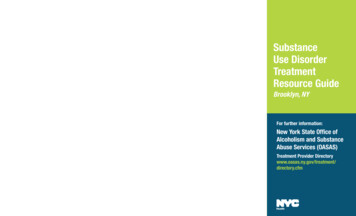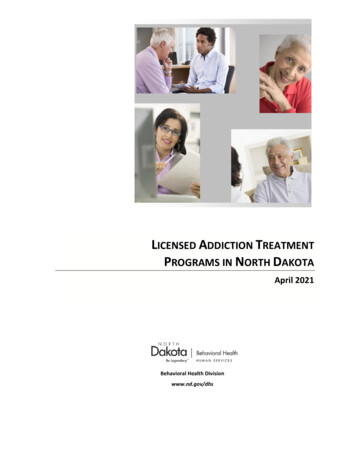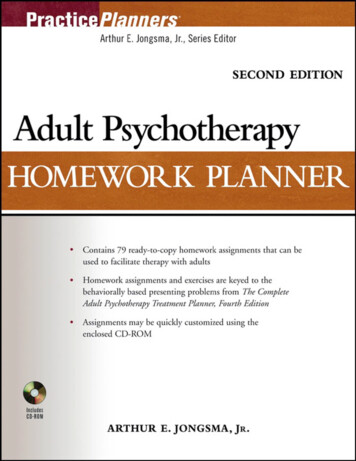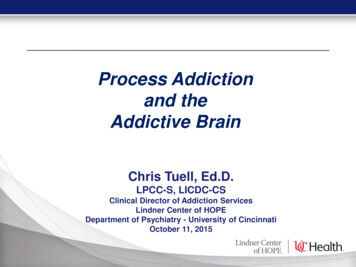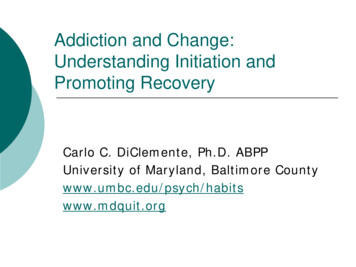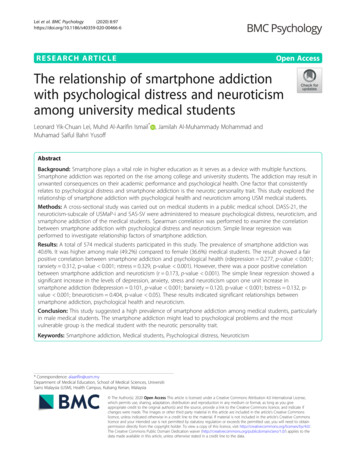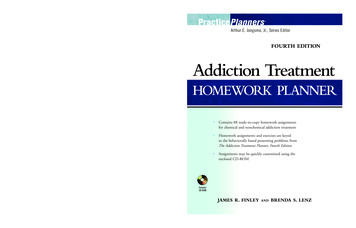
Transcription
THE BESTSELLING TREATMENT PLANNING SYSTEMFOR MENTAL HEALTH PROFESSIONALSHelp clients suffering from chemical and nonchemical addictionsdevelop the skills they need to work through problems Revised homework assignments reflecting clients’ stages of readiness and change New appendices to help you select exercises based on American Society of Addiction JAMES R. FINLEY, MA, is a practicing psychotherapist with experience in a variety of community and correctional settings, outpatient and inpatient. He is the author of Integrating the 12Steps into Addiction Therapy and coauthor of The Addiction Counselor’s Documentation Sourcebook, SecondEdition, both published by Wiley.BRENDA S. LENZ, MS, is a licensed professional counselor and certified substance abuse counselor. She specializes in treating addictions in women and college-aged students and is coauthor ofThe Addiction Counselor’s Documentation Sourcebook, Second Edition, published by Wiley. She currentlyworks in a university counseling center and in private practice.Additional resources in the PracticePlanners series:Treatment PlannersProgress NotesPlannerscontain complete,prewritten progressnotes for each presentingproblem in thecompanion TreatmentPlanners Arthur E. Jongsma, Jr., Series EditorFOURTH EDITIONAddiction TreatmentHOMEWORK PLANNERFOURTH EDITIONcover all the necessary elementsfor developing formal treatmentplans, including detailedproblem definitions, long-termgoals, short-term objectives,therapeutic interventions, andDSM diagnoses.Addiction Treatment HOMEWORK PLANNER Medicine (ASAM) criteria88 ready-to-copy exercises covering the most common issues encountered by clients suffering from chemical and nonchemical addictions, such as anxiety, impulsivity, childhood trauma,dependent traits, and occupational problemsA quick-reference format—the interactive assignments are grouped by behavioral problems including alcoholism, nicotine dependence, and substance abuse, as well as those problems that do notinvolve psychoactive substances, such as problem gambling, eating disorders, and sexual addictionsExpert guidance on how and when to make the most efficient use of the exercisesAssignments that are cross-referenced to The Addiction Treatment Planner, Fourth Edition—so youcan quickly identify the right exercise for a given situation or problemA CD-ROM that contains all the exercises in Microsoft Word format—allowing you tocustomize them to suit you and your clients’ unique styles and needsPracticePlannersFinley LenzThe Addiction Treatment Homework Planner, Fourth Edition provides you with an array ofready-to-use, between-session assignments designed to fit virtually every therapeutic mode.This easy-to-use sourcebook features:PracticePlannersPracticePlanners Contains 88 ready-to-copy homework assignmentsfor chemical and nonchemical addiction treatment Homework assignments and exercises are keyedto the behaviorally based presenting problems fromThe Addiction Treatment Planner, Fourth Edition Assignments may be quickly customized using theenclosed CD-ROMFor more information on our PracticePlanners products, including our full line ofTreatment Planners, visit us on the Web ludesCD-ROMJAMES R. FINLEYANDBRENDA S. LENZ
ffirs.pdf 44/23/2009 12:43:05 PM
ffirs.pdf 14/23/2009 12:43:04 PM
ffirs.pdf 24/23/2009 12:43:04 PM
ffirs.pdf 34/23/2009 12:43:05 PM
ffirs.pdf 44/23/2009 12:43:05 PM
Addiction TreatmentHomework Plannerffirs.pdf 54/23/2009 12:43:05 PM
ffirs.pdf 64/23/2009 12:43:05 PM
PracticePlanners Addiction TreatmentHomework PlannerFourth EditionJames R. FinleyBrenda S. LenzJohn Wiley & Sons, Inc.ffirs.pdf 74/23/2009 12:43:05 PM
This book is printed on acid-free paper.Copyright 2009 by James R. Finley and Brenda S. Lenz. All rights reserved.Published by John Wiley & Sons, Inc., Hoboken, New Jersey.Published simultaneously in Canada.No part of this publication may be reproduced, stored in a retrieval system, or transmitted in any form or by anymeans, electronic, mechanical, photocopying, recording, scanning, or otherwise, except as permitted underSection 107 or 108 of the 1976 United States Copyright Act, without either the prior written permission of thePublisher, or authorization through payment of the appropriate per-copy fee to the Copyright Clearance Center,Inc., 222 Rosewood Drive, Danvers, MA 01923, (978) 750-8400, fax (978) 646-8600, or on the web atwww.copyright.com. Requests to the Publisher for permission should be addressed to the Permissions Department,John Wiley & Sons, Inc., 111 River Street, Hoboken, NJ 07030, (201) 748-6011, fax (201) 748-6008.Limit of Liability/Disclaimer of Warranty: While the publisher and author have used their best efforts inpreparing this book, they make no representations or warranties with respect to the accuracy or completeness ofthe contents of this book and specifically disclaim any implied warranties of merchantability or fitness for aparticular purpose. No warranty may be created or extended by sales representatives or written sales materials.The advice and strategies contained herein may not be suitable for your situation. You should consult with aprofessional where appropriate. Neither the publisher nor author shall be liable for any loss of profit or anyother commercial damages, including but not limited to special, incidental, consequential, or other damages.This publication is designed to provide accurate and authoritative information in regard to the subject mattercovered. It is sold with the understanding that the publisher is not engaged in rendering professional services. Iflegal, accounting, medical, psychological, or any other expert assistance is required, the services of a competentprofessional person should be sought.Designations used by companies to distinguish their products are often claimed as trademarks. In all instanceswhere John Wiley & Sons, Inc. is aware of a claim, the product names appear in initial capital or all capitalletters. Readers, however, should contact the appropriate companies for more complete information regardingtrademarks and registration.For general information on our other products and services please contact our Customer Care Departmentwithin the U.S. at (800) 762-2974, outside the United States at (317) 572-3993 or fax (317) 572-4002.Wiley also publishes its books in a variety of electronic formats. Some content that appears in print may not beavailable in electronic books. For more information about Wiley products, visit our website at www.wiley.com.Library of Congress Cataloging-in-Publication Data:Finley, James R., 1948Addiction treatment homework planner / James R. Finley, Brenda S. Lenz.—4th ed.p. cm. — (Practice planners series)Includes bibliographical references.ISBN 978-0-470-40274-0 (paper/CD-Rom)1. Substance abuse—Treatment—Handbooks, manuals, etc. 2. Substance abuse—Treatment—Planning.I. Lenz, Brenda S. II. Title.RC564.15.F555 2009616.89—dc222009000842Printed in the United States of America10 9 8 7 6 5 4 3 2 1ffirs.pdf 84/23/2009 12:43:05 PM
This book is dedicated to our loved ones, who’ve given us somuch encouragement and been so unselfish in the face ofour work’s demands, and to all the clients and colleagueswho’ve taught us and inspired us over the years. Withoutyou all this would be impossible. Thank you.ffirs.pdf 94/23/2009 12:43:05 PM
ffirs.pdf 104/23/2009 12:43:05 PM
CONTENTS Practice Planner Series PrefacePrefacexixxxiSECTION I—Adult-Child-of-an-Alcoholic (ACOA) Traits1Exercise I.AUnderstanding Codependent Behaviors2Exercise I.BUnderstanding Family History5SECTION II—AngerExercise II.AExercise II.B7Is My Anger Due to Feeling Threatened?Is My Anger Due to Unmet Expectations?SECTION III—Antisocial BehaviorExercise III.AExercise III.BAlternatives to Addictive BehaviorTaking Daily InventorySECTION IV—AnxietyExercise IV.AExercise IV.B81114151921Coping with StressMy Anxiety ProfileSECTION V—Attention Deficit Disorder, Inattentive Type (ADD)222629Exercise V.AGetting Organized30Exercise V.BNegotiating Skills for Success34SECTION VI—Attention Deficit/Hyperactivity Disorder (ADHD)37Exercise VI.AFrom Recklessness to Calculated Risks38Exercise VI.BLearning to Self-Soothe41SECTION VII—Borderline TraitsExercise VII.AExercise VII.BForming Stable RelationshipsSeeing That We’re All Just Human434449xiftoc.pdf 14/21/2009 2:40:35 PM
xiiCONTENTSSECTION VIII—Childhood TraumaExercise VIII.ACorresponding with My Childhood Self53Exercise VIII.BSetting and Maintaining Boundaries56SECTION IX—Chronic Pain58Exercise IX.AAlternative Methods for Managing Pain59Exercise IX.BCoping with Addiction and Chronic Pain63SECTION X—Dangerousness/Lethality66Exercise X.AAnger as a Drug67Exercise X.BRespect or Fear?70SECTION XI—Dependent TraitsExercise XI.AExercise XI.BBuilding My Support NetworkHow Independent Am I?747579SECTION XII—DepressionExercise XII.ACorrecting Distorted ThinkingExercise XII.BWhat’s Happening in My Early Recovery?818286SECTION XIII—Eating DisordersExercise XIII.ACreating a Preliminary Health PlanExercise XIII.BEating Patterns Self-Assessment888993SECTION XIV—Family ConflictsExercise XIV.ACreating a Family RitualExercise XIV.BIdentifying Conflict Themes9697100SECTION XV—GamblingExercise XV.AUnderstanding Nonchemical AddictionsExercise XV.BWhat Price Am I Willing to Pay?103104108SECTION XVI—Grief/Loss UnresolvedExercise XVI.AAm I Having Difficulty Letting Go?Exercise XVI.BMoving on with My Life112113117SECTION XVII—ImpulsivityExercise XVII.AA Different Approach120121Exercise XVII.Bftoc.pdf 252Handling Crisis1244/21/2009 2:40:36 PM
CONTENTSSECTION XVIII—Legal Problems127Exercise XVIII.AHandling Tough Situations in a Healthy Way128Exercise XVIII.BWhat’s Addiction Got to Do with My Problems?132SECTION XIX—Living Environment Deficiency135Exercise XIX.AAssessing My Needs136Exercise XIX.BWhat Would My Ideal Life Look Like?139SECTION XX—Mania/HypomaniaExercise XX.AExercise XX.B142Coping with Addiction and MoodDisorders or Bereavement143Early Warning Signs of Mania/Hypomania147SECTION XXI—Medical Issues149Exercise XXI.ACoping with Addiction and Other Medical Problems150Exercise XXI.BPhysical and Emotional Self-Care154SECTION XXII—Narcissistic Traits156Exercise XXII.ABeing Genuinely Unselfish157Exercise XXII.BGetting Out of Myself160SECTION XXIII—Nicotine Dependence162Exercise XXIII.AAvoiding Nicotine Relapse Triggers163Exercise XXIII.BUse of Affirmations for Change168SECTION XXIV—Occupational Problems171Exercise XXIV.ABarriers and Solutions172Exercise XXIV.BInterest and Skill Self-Assessment176SECTION XXV—Opioid Dependence179Exercise XXV.AMaking Change Happen180Exercise XXV.BA Working Recovery Plan184SECTION XXVI—Oppositional Defiant Behaviorftoc.pdf 3xiii187Exercise XXVI.AAnalyzing Acting-Out Behavior188Exercise XXVI.BLearning to Ask Instead of Demand1924/21/2009 2:40:36 PM
xivCONTENTSSECTION XXVII—Parent–Child Relational ProblemExercise XXVII.AAm I Teaching My Children Addictive Patterns?195Exercise XXVII.BWhat Do I Want for My Children?199SECTION XXVIII—Partner Relational Conflicts202Exercise XXVIII.A Communication Skills203Exercise XXVIII.B Identifying Proven Problem-Solving Skills209SECTION XXIX—Peer Group Negativity212Exercise XXIX.AWhat Do I Need and How Do I Get It?213Exercise XXIX.BWhat Do Others See Changing?217SECTION XXX—Posttraumatic Stress Disorder (PTSD)Exercise XXX.AExercise XXX.B219Coping with Addiction and PTSD or OtherAnxiety Disorders220Safe and Peaceful Place Meditation224SECTION XXXI—Psychosis227Exercise XXXI.ACoping with Addiction and Thought Disorders228Exercise XXXI.BPlanning for Stability231SECTION XXXII—Relapse Proneness233Exercise XXXII.AEarly Warning Signs of Relapse234Exercise XXXII.BIdentifying Relapse Triggers and Cues238Exercise XXXII.CRelapse Prevention Planning242SECTION XXXIII—Self-Care Deficit as a Primary Problem245Exercise XXXIII.A Assessing Self-Care Deficits246Exercise XXXIII.B Relating Self-Care Deficits to My Addiction249SECTION XXXIV—Self-Care Deficit as a Secondary Problem251Exercise XXXIV.A Filling in the Gaps252Exercise XXXIV.B Working toward Independence255SECTION XXXV—Sexual Promiscuityftoc.pdf 4194257Exercise XXXV.AIs It Romance or Is It Fear?258Exercise XXXV.BWorking through Shame2624/21/2009 2:40:36 PM
CONTENTSSECTION XXXVI—Social Anxiety264Exercise XXXVI.A Understanding My Defense Mechanisms265Exercise XXXVI.B Using My Support Network269SECTION XXXVII—Spiritual Confusion271Exercise XXXVII.A Understanding Spirituality272Exercise XXXVII.B What Do I Believe In?276SECTION XXXVIII—Substance Abuse/Dependence279Exercise XXXVIII.A Balancing Recovery, Family, and Work280Exercise XXXVIII.B Consequences of Continuing Addictive Lifestyles284Exercise XXXVIII.C Personal Recovery Planning288Exercise XXXVIII.D Problem Identification295Exercise XXXVIII.E What Does Addiction Mean to Me?298SECTION XXXIX—Substance-Induced Disorders301Exercise XXXIX.A Identifying and Using Community Resources302Exercise XXXIX.B Planning Aftercare307SECTION XL—Substance Intoxication/Withdrawal310Exercise XL.ACoping with Post-Acute Withdrawal311Exercise XL.BUsing Books and Other Media Resources314SECTION XLI—Suicidal IdeationExercise XLI.AExercise XLI.B316What Did I Want to Be When I Grew Up?Why Do I Matter and Who Cares?317321SECTION XLII—Treatment ResistanceExercise XLII.AExercise XLII.Bftoc.pdf 5xv324How Far Have I Come?Setting and Pursuing Goals in Recovery325329Appendix A: Additional Assignments for Presenting Problems332Appendix B: Stages of ChangeAppendix C: ASAM Adult Patient Placement Criteria Dimensions344349Appendix D: Suggested Addiction Homework Treatment Plan Exercises,ASAM Dimensions, and ASAM Levels of Care352About the CD-ROM3564/21/2009 2:40:36 PM
ftoc.pdf 64/21/2009 2:40:36 PM
PRACTICEPLANNERS SERIES PREFACEAccountability is an important dimension of the practice of psychotherapy. Treatmentprograms, public agencies, clinics, and practitioners must justify and document theirtreatment plans to outside review entities in order to be reimbursed for services. Thebooks and software in the PracticePlanners series are designed to help practitionersfulfill these documentation requirements efficiently and professionally.The PracticePlanners series includes a wide array of treatment-planning books, including not only the original Complete Adult Psychotherapy Treatment Planner, ChildPsychotherapy Treatment Planner, and Adolescent Psychotherapy Treatment Planner,all now in their fourth editions, but also Treatment Planners targeted to a wide range ofspecialty areas of practice, including: Addictions Behavioral medicine College students Co-occurring disorders Couples therapy Crisis counseling Early childhood education Employee assistance Family therapy Gays and lesbians Group therapy Juvenile justice and residential care Mental retardation and developmental disability Neuropsychology Older adults Parenting skills Pastoral counseling Personality disorders Probation and parole Psychopharmacology School counseling Severe and persistent mental illness Sexual abuse victims and offenders Special education Suicide and homicide risk assessmentxviifspre.pdf 14/27/2009 9:18:17 AM
xviii PRACTICEPLANNERS SERIES PREFACE Veterans and active duty militaryWomen’s issuesIn addition, there are three branches of companion books that can be used in conjunction with the Treatment Planners, or on their own: Progress Notes Planners provide a menu of progress statements that elaborateon the client’s symptom presentation and the provider’s therapeutic intervention.Each Progress Notes Planner statement is directly integrated with the behavioraldefinitions and therapeutic interventions from its companion Treatment Planner. Homework Planners include homework assignments designed around each presenting problem (e.g., anxiety, depression, chemical dependence, anger management, eating disorders, or panic disorder) that is the focus of a chapter in its corresponding Treatment Planner. Client Education Handout Planners provide brochures and handouts to helpeducate and inform clients on presenting problems and mental health issues, aswell as life skills techniques. The handouts are included on CD-ROMs for easyprinting from your computer and are ideal for use in waiting rooms, at presentations, as newsletters, or as information for clients struggling with mental illnessissues. The topics covered by these handouts correspond to the presenting problems in the Treatment Planners.The series also includes: TheraScribe , the best-selling treatment-planning and clinical record-keeping software system for mental health professionals. TheraScribe allows the user toimport the data from any of the Treatment Planner, Progress Notes Planner, orHomework Planner books into the software’s expandable database to simply pointand click to create a detailed, organized, individualized, and customized treatmentplan along with optional integrated progress notes and homework assignments.Adjunctive books, such as The Psychotherapy Documentation Primer and The ClinicalDocumentation Sourcebook contain forms and resources to aid the clinician in mentalhealth practice management.The goal of our series is to provide practitioners with the resources they need in order to provide high-quality care in the era of accountability. To put it simply: We seekto help you spend more time on patients and less time on paperwork.ARTHUR E. JONGSMA JR.Grand Rapids, Michiganfspre.pdf 24/27/2009 9:18:17 AM
PREFACECHANGES IN THIS EDITION OF THE HOMEWORK PLANNERThe field of psychotherapy in general, and addiction treatment in particular, continuesto evolve. Since completing the third edition we have seen ongoing movement fromfixed, program-driven interventions toward more flexible, individualized, assessmentbased, clinically driven treatment. Providers and consumers seek approaches recognizing the impact of client readiness and motivation in the treatment process. People entertreatment at all stages of readiness, and clinicians need to help some increase motivation for change and others move from one stage of readiness to the next. We have revised assignments with stages of readiness and change in mind and added appendicesto help select exercises based on American Society of Addiction Medicine (ASAM) criteria. At the same time, there is more demand for treatment strategies and interventionsto be evidence-based, and we have sought to reflect this trend.While we have updated and retained the 88 exercises in 42 problem areas in thethird edition, in response to feedback from colleagues and clients we have condensedsome content. We have reduced the overviews to one page or less apiece. Most exercisesare one or two pages in length, and none are longer than three pages. Our hope is thatthese changes will make this book even more useful than the previous edition. We believe it is more important than ever to include therapeutic homework in treatment forseveral reasons: The process of working on these exercises between therapy sessions helps clientsintegrate their treatment into their daily life and all the environments in whichthey live. When newly recovering people encounter problems and challenges, it seldom happens in session—in a way, these homework assignments enable us to extend thereach of the process from individual or group sessions into the client’s home, work,and social life. As we noted in the preface to the third edition, homework makes effective use ofthe time between sessions, empowers the client and leads him/her into a more active role in treatment, gives the therapist documentation of progress and a vehiclefor giving the client feedback, and provides the client a reference to keep and uselong after treatment ends.xixfpref.pdf 14/23/2009 10:33:01 AM
xxPREFACEUSING THIS BOOKThis revision is a companion to the fourth edition of the Addiction Treatment Planner. It is compatible with the fourth edition of the Therascribe treatment-planning software. As before, you can look assignments up by issue or assignment title in the tableof contents; use the appendices to cross-reference assignments with treatment issues;and use the enclosed CD-ROM to install the assignments on your computer as MicroSoft Word documents and print them as they are or customize them by rewordingitems, adding a logo or other art, or however else you choose. For further instructionsplease see “About the CD-ROM” at the back of this book. You may also use the companion CD-ROM add-on module with the TheraScribetreatment-planning software to import goals and exercises directly into treatmentplans.As always, if you have suggestions, or want to tell us which features you find especially useful, please contact us via John Wiley & Sons, Inc. We are always grateful forfeedback and have found it helpful in bringing you the best resource we can. Thanks formaking the world a better place.fpref.pdf 24/23/2009 10:33:01 AM
SECTION I: ADULT-CHILD-OF-AN-ALCOHOLIC (ACOA) TRAITSTherapist’s OverviewUNDERSTANDING CODEPENDENT BEHAVIORSGOALS OF THE EXERCISE1.2.3.4.5.6.Implement a plan for recovery from addiction that reduces the impact of adultchild-of-an-alcoholic (ACOA) traits on sobriety.Decrease dependence on relationships while beginning to meet one’s own needs.Reduce the frequency of behaviors that are exclusively designed to please others.Choose partners and friends who are responsible, respectful, and reliable.Overcome fears of abandonment, loss, and neglect.Understand the feelings that resulted from being raised in an addictive environment and reduce feelings of alienation by seeing similarities to others raised innonaddictive homes.ADDITIONAL PROBLEMS FOR WHICH THIS EXERCISE MAY BE USEFUL Borderline TraitsDependent TraitsPartner Relationship ConflictSexual PromiscuitySUGGESTIONS FOR PROCESSING THIS EXERCISE WITH THE CLIENTThe “Understanding Codependent Behaviors” activity is for clients with patterns of codependent relationships, enmeshment, and boundary issues. It teaches clients aboutaddictive relationship dynamics, then heightens motivation by focusing on the threatthis poses to recovery, ending by directing clients to further exploration of issues of codependency. Follow-up may include discussing the issue with the therapist, group, andsponsor; support group referrals; bibliotherapy; and videotherapy (e.g., Rent Two Filmsand Let’s Talk in the Morning by John W. Hesley and Jan G. Hesley, also published byJohn Wiley & Sons).ADULT-CHILD-OF-AN-ALCOHOLIC (ACOA) TRAITS 1c01.pdf 14/22/2009 3:33:34 PM
EXERCISE I.AUNDERSTANDING CODEPENDENT BEHAVIORSCodependency is addiction to a relationship. A codependent tries so hard to “fix” or“save” someone else that his/her own life is left in turmoil. No one can control anyoneelse—other people’s troubles are mostly due to patterns only they can change, so tryingto change them leads to one painful disappointment after another.1.There are reasons we’re drawn to relationships in which we try harder to solve ourpartners’ problems than they do. These patterns are often related to having grownup with parents or other adults who suffered from alcoholism, other drug addiction, or other addictive disorders, and may echo our childhood relationships withthose adults. Have you been in painful relationships for any of these reasons?You felt needed.It was intense and exciting from the start.You felt intensely and “magnetically” drawn to them.They made you feel strong, smart, and capable.The sex was incredible.You identified with the hardships they’d suffered—your heart ached forthem.You felt that you could help them and change their lives.2.Here are signs of codependent relationships. Again, please check off any you’veexperienced:Manipulation and mind games take up a lot of time and energy.You’re often worried that the relationship will fall apart, so you walk on eggshells.You keep your partner away from your other friends and family becausethey don’t get along, or you don’t think they would.One of you spends a lot of time rescuing the other from problems, againand again.You try hard to impress your partner and keep secrets; you fear yourpartner would reject you if he/she knew about parts of your life or past.You get in heated arguments that don’t make sense to either of you.2 ADULT-CHILD-OF-AN-ALCOHOLIC (ACOA) TRAITSc01.pdf 24/22/2009 3:33:34 PM
EXERCISE I.AThe relationship became very intense very fast when you first got together.One or both of you feel a lot of jealousy and insecurity about the relationship.The relationship is never boring, but it’s usually stressful.You go back and forth between feeling abandoned and feeling smothered.3.There’s a strong connection between stress and relapse. Looking at the items youchecked for question 2, how could a stressful relationship lead you to relapse andhow do you feel about that risk?4.Most people who get into codependent relationships don’t just do so once. Each ofus has a type we’re most likely to be drawn to. What unhealthy patterns do you seein the people you find attractive?Be sure to bring this handout back to your next session with your therapist, and beprepared to talk about your thoughts and feelings about the exercise.ADULT-CHILD-OF-AN-ALCOHOLIC (ACOA) TRAITS 3c01.pdf 34/22/2009 3:33:34 PM
Therapist’s OverviewUNDERSTANDING FAMILY HISTORYGOALS OF THE EXERCISE1. Implement a plan for recovery from addiction that reduces the impact of adultchild-of-an-alcoholic (ACOA) traits on sobriety.2. Decrease dependence on relationships while beginning to meet one’s own needs.3. Reduce the frequency of behaviors that are exclusively designed to please others.4. Eliminate behaviors that are dangerous to self or others.5. Eliminate self-defeating interpersonal patterns in occupational and social settings.6. Choose partners and friends who are responsible, respectful, and reliable.7. Overcome fears of abandonment, loss, and neglect.8. Understand the feelings that resulted from being raised in an addictive environment and reduce feelings of alienation by seeing similarities to others raised innonaddictive homes.9. Learn new ways to interact with the family in adult life.10. Obtain emotional support for recovery from family members.ADDITIONAL PROBLEMS FOR WHICH THIS EXERCISE MAY BE USEFUL Childhood TraumaFamily ConflictsParent-Child Relational ProblemSUGGESTIONS FOR PROCESSING THIS EXERCISE WITH THE CLIENTThe “Understanding Family History” activity may be used effectively with clients experiencing shame, confusion, or anxiety as a result of seeing themselves repeat negativebehaviors seen in childhood caretakers. It may be useful in couples therapy, since manyACOA individuals form relationships with partners with similar backgrounds. For clients struggling with acceptance and forgiveness of their parents or of themselves, thisactivity may help in understanding the roles of addiction and powerlessness in distorting values and behaviors. It may also be useful for clients who have parenting issues inrecovery to understand the roots of their children’s behaviors.4 ADULT-CHILD-OF-AN-ALCOHOLIC (ACOA) TRAITSc01.pdf 44/22/2009 3:33:34 PM
EXERCISE I.BUNDERSTANDING FAMILY HISTORYIt’s important to understand the role of family history in addictions, not to assess blamebut for your own recovery and your family’s future. This exercise looks at how familyhistory affects us.1.As a child, what did you learn about drinking, drug use, or other addictions in yourfamily?2.What problems, if any, did your family have because of these behaviors (e.g., violence, divorce, financial problems, dangerous or illegal activities, or other worries)?3.Please describe the typical atmosphere in your family when someone was drinking,using drugs, or engaging in other addictive patterns, and its effects on you thenand now.4.Here are some common patterns in families struggling with addictions, related tothe unspoken rule “Don’t talk, don’t trust, don’t feel” that develops as other familymembers, especially children, try to avoid confrontations or disappointment due tothe inability of addicted adults to be nurturing and dependable, or to cope with theemotional pain that is the result of that inability. For each pattern, give an examplefrom your childhood and an example of how you can make healthy changes now.a. Dishonesty/denial(1) Childhood example:ADULT-CHILD-OF-AN-ALCOHOLIC (ACOA) TRAITS 5c01.pdf 54/22/2009 3:33:34 PM
EXERCISE I.B(2) Working for healthy change:b. Breaking promises(1) Childhood example:(2) Working for healthy change:c.Isolating/withdrawing(1) Childhood example:(2) Working for healthy change:d. Emotional/physical/sexual abuse and neglect(1) Childhood example:(2) Working for healthy change:e. Influencing others to act in self-destructive ways(1) Childhood example:(2) Working for healthy change:f.Confused roles and responsibilities (e.g., children taking caring of adults, peopleblaming others for their own actions, etc.)(1) Childhood example:(2) Working for healthy change:5.What good relationship patterns from your childhood do you want to continue andpass on?Be sure to bring this handout back to your next session with your therapist, and beprepared to talk about your thoughts and feelings about the exercise.6 ADULT-CHILD-OF-AN-ALCOHOLIC (ACOA) TRAITSc01.pdf 64/22/2009 3:33:34 PM
SECTION II: ANGERTherapist’s OverviewIS MY ANGER DUE TO FEELING THREATENED?GOALS OF THE EXERCISE1.2.3.4.5.6.7.8.9.Develop a program of recovery that is free from substance abuse and dangerous/lethal behaviors.Terminate all behaviors that are dangerous to self or others.Decrease the frequency of occurrence of angry thoughts, feelings, and behaviors.Verbalize core conflicts that lead to dangerous/lethal behaviors.Recognize the first signs of anger and use behavioral techniques to control it.Think positively and realistically in anger-producing situations.Come to see that anger is a sec
Homework Planner ffirs.pdf 5 4/23/2009 12:43:05 PM. ffirs.pdf 6 4/23/2009 12:43:05 PM. Addiction Treatment Homework Planner _ Fourth Edition James R. Finley Brenda S. Lenz John Wiley & Sons, Inc. PracticePlanner


